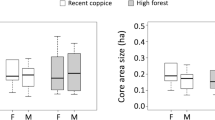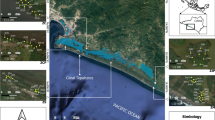Abstract
Northern small rodents are well known for their population cycles which represent a key process for the functioning of arctic and boreal ecosystems. Habitat use often changes in the course of the cycle. Higher densities can either lead to spill-over into secondary habitats or to increased habitat specificity because of interspecific competition. Here we investigate whether voles in the shrub tundra of southern Yamal exhibit density dependent habitat use. Voles were trapped at the Erkuta Tundra Monitoring Site (N 68.2°, E 69.2°) in three characteristic habitats over five years covering all phases of the population cycle. Our analyses focused on the two most numerous species Microtus gregalis (52% of individuals caught) and M. middendorffii (36%). A small-scale spill-over effect was observed for M. gregalis, which increasingly used the open habitat adjacent to their preferred willow thickets at high abundance. At a larger scale no such effect was observed for the two Microtus species - a result which is explained by the overall moderate densities of voles and the large spatial extent of the primary habitat of M. middendorffii: moist moss dwarf shrub tundra.
Similar content being viewed by others
References
Balakhonov, V.S., Shtro, V.G., 1995. Some species of terrestrial vertebrates of the shrub tundra subzone of Yamal. In: Balakhonov, V.S. (Ed.), Present State of the Flora and Fauna of Yamal Peninsula. Nauka, Ekaterinburg, Russia, pp. 159–193 (in Russian).
Batsaikhan, N., Tsytsulina, K., Formozov, N., Sheftel, B., 2008. Microtus gregalis. In: IUCN Red List of Threatened Species. Version 2012.2 (downloaded on 18.01.13) https://doi.org/www.iucnredlist.org
Bates, D., Maechler, M., Dai, B., 2008. Lme4: Linear Mixed-Effects Models using s4 Classes (version 0.999375–20) [computer software], Available at: https://doi.org/cran.R-project.Org/
Batzli, G.O., Henttonen, H., 1990. Demography and resource use by microtine rodents nearToolik Lake Alaska, USA. Arctic Alpine Res. 22, 51–64.
Batzli, G.O., White, R.G., MacLean, S.F., Pitelka, F.A., Collier, B., 1980. The herbivore-based trophic system. In: Brown, J., Miller, P.C., Tieszen, L.L., Bunnell, F.L. (Eds.), An Arctic Ecosystem: The Coastal Tundra at Barrow. Dowden, Hutchinson, and Ross, Stroudsburg, PA, pp. 335–410.
Benenson, I.E., 1982. The influence of migration on the regularity of the lemming cycles. Mammals of the USSR. In: Proceedings of the Russian conference of mammal researchers 1, pp. 59–160 (in Russian).
Borodin, A.V., 2009. Guide on Teeth of Voles of Ural and Western Siberia (late Pleistocene-today). Ural Branch of Russian Academy of Sciences, Ekaterinburg, Russia (in Russian).
Bråthen, K.A., Hagberg, O., 2004. More efficient estimation of plant biomass. J. Veg. Sci. 15, 653–660.
Brommer, J.E., Pietiainen, H., Ahola, K., Karell, P., Karstinen, T., Kolunen, H., 2010. The return of the vole cycle in southern Finland refutes the generality of the loss of cycles through ‘climatic forcing’. Global Change Biol. 16, 577–586.
Chapin, F.S., BretHarte, M.S., Hobbie, S.E., Zhong, H.L., 1996. Plant functional types as predictors of transient responses of arctic vegetation to global change. J. Veg. Sci. 7, 347–358.
Danilov, A.N., 2000. Dynamics and Spatial Distribution of Tundra Rodents in Southern Yamal. (Ph.D. dissertation). Institute of Plant and Animal Ecology of Ural Branch of Russian Academy of Sciences, Ekaterinburg, Russia (in Russian).
Dunaeva, T.N., 1948. Comparative review of ecology of tundra voles of Yamal Peninsula. In: Formozov, A.N. (Ed.), Materials of the Institute of Geography of Academy of Sciences of USSR. Academy of Sciences of USSR, Moscow, USSR, pp. 78–143 (in Russian).
Ehrich, D., Henden, J.H., Ims, R.A., Doronina, L.O., Killengren, S.T., Lecomte, N., Pokrovsky, I.G., Skogstad, G., Sokolov, A.A., Sokolov, V.A., Yoccoz, N.G., 2012. The importance of willow thickets for ptarmigan and hares in shrub tundra: the more the better? Oecologia 168, 141–151.
Ehrich, D., Yoccoz, N.G., Ims, R.I., 2009. Multi-annual density fluctuations and habitat size enhance genetic variability in two northern voles. Oikos 118, 1441–1452.
Ekerholm, P., Oksanen, L, Oksanen, T., 2001. Long-term dynamics of voles and lemmings at the timberline and above the willow limit as a test of hypotheses on trophic interactions. Ecography 24, 555–568.
Elshin, S.V., 1983. Zonal Landscape Particularities of Small Mammal Populations and their Ectoparasites in the Northern Ob’ Basin. (Ph.D. dissertation). University of Novosibirsk, Novosibirsk, USSR (in Russian).
Elton, C.S., 1924. Periodic fluctuations in the numbers of animals -Their causes and effects. Br. J. Exp. Biol. 2, 119–163.
Flint, V.E., Chugunov, Y., Smirin, V., 1970. Middendorffs vole. In: Formozov, A.N. (Ed.), Mammals of the USSR. Mysl, Moscow, USSR, p. 389 (in Russian).
Hanski, I., Henttonen, H., 1996. Predation on competing rodent species: simple explanation of complex patterns. J. Anim. Ecology. 65, 220–232.
Hanski, I., Henttonen, H., Hansson, L., 1994. Temporal variability and geographical patterns in the population density of microtine rodents: a reply to Xia and Boonstra. Am. Nat. 144,329-342.
Hansson, L., 1983. Competition between rodents in successional stages of the taiga forests - Microtus agrestis vs Clethrionomys glareolus. Oikos 40, 258–266.
Henden, J.A., Ims, R.A., Yoccoz, N.G., Killengreen, S.T., 2011a. Declining willow ptarmigan populations: the role of habitat structure and community dynamics. Basic Appl. Ecol. 12, 413–422.
Henden, J.A., Ims, R.A., Yoccoz, N.G., Sorensen, R., Killengreen, S.T., 2011b. Population dynamics of tundra voles in relation to configuration of willow thickets in southern arctic tundra. Polar Biol. 34, 533–540.
Henttonen, H., Kaikusalo, A., Tast, J., Viitala, J., 1977. Interspecific competition between small rodents in sub-arctic and boreal ecosystems. Oikos 29, 581–590.
Hovland, N., Andreassen, H.P., Ims, R.A., 1999. Foraging behaviour of the root vole Microtus oeconomus in fragmented habitats. Oecologia 121, 236–244.
Ims, R.A., Andreassen, H.P., 2005. Density-dependent dispersal and spatial population dynamics. Proc. R. Soc. B. 272, 913–918.
Ims, R.A., Yoccoz, N.G., Killengreen, S.T., 2011. Determinants of lemming outbreaks. Proc. Natl. Acad. Sci. U.S.A. 108, 1970–1974.
Johannesen, E., Mauritzen, M., 1999. Habitat selection of grey-sided voles and bank voles in two subalpine populations in southern Norway. Ann. Zool. Fenn. 36, 215–222.
Krebs, C.J., Reid, D., Kenney, A.J., Gilbert, S., 2011. Fluctuations in lemming populations in north Yukon Canada, 2007–2010. Can. J. Zool. 89, 297–306.
Löfgren, O., 1995. Niche expansion and increased maturation rate of Clethrionomys glareolus in the absence of competitors.J. Mammal. 76, 1100–1112.
Magomedova, M.A., Morozova, L.M., Ektova, S.N., Rebristaya, O.V., Chernyadyeva, I.V., Potemkin, A.D., Knyazev, M.C., 2006. Yamal Peninsula: Vegetation Cover. City Press, Tyumen, Russia.
Morris, D.W., Davidson, D.L., Krebs, C.J., 2000. Measuring the ghost of competition: insights from density-dependent habitat selection on the co-existence and dynamics of lemmings. Evol. Ecol. Res. 2, 41–67.
Myllymäki, A., Paasikallio, A., Pankakoski, E., Kanervo, V., 1971. Removal experiments on small quadrats as a mean of rapid assessment of the abundance of small mammals. Ann. Zool. Fenn. 8, 177–185.
Mysterud, A., Ims, R.A., 1998. Functional responses in habitat use: availability influences relative use in trade-off situations. Ecology 79, 1435–1441.
Pajunen, A.M., Kaarlejarvi, E.M., Forbes, B.C., Virtanen, R., 2010. Compositional differentiation, vegetation-environment relationships and classification of willow-characterised vegetation in the western Eurasian Arctic. J. Veg. Sci. 21, 107–119.
Petrov, A.N., 1994. The collared lemming. In: Yestafyev, A.A. (Ed.), Fauna of the European North-East of Russia. Mammals, vol. 1 Part 2. Nauka, St. Petersburg, Russia, pp. 202–212.
Pokrovsky, I.G., Ehrich, D., Ims, R.A., Kulikova, O., Lecomte, N., Yoccoz, N.G., 2014. Diet, nesting density, and breeding success of rough-legged buzzards (Buteo lagopus) on the Nenetsky Ridge, Arctic Russia. Polar Biol., https://doi.org/dx.doi.org/10.1007/s00300-013-1441-2.
R Core Team, 2012. R: A Language and Environment for Statistical Computing. R Foundation for statistical computing, Vienna, Austria.
Rosenzweig, M.L., 1981. A theory of habitat selection. Ecology 62, 327–335.
Rosenzweig, M.L., 1991. Habitat selection and population interactions - the search for mechanism. Am. Nat. 137, S5–S28.
Schwartz, S.S., Pyastolova, O.A., 1971. Middendorff’s vole. In: Schwartz, S.S. (Ed.), Mammals of Yamal and the Polar Urals - Proceedings of Institute of Plant and Animal Ecology UNC AS of USSR I. UNC AS of USSR Publishers, Sverdlovsk, USSR, pp. 197–126 (in Russian).
Smith, J.E., Batzli, G.O., 2006. Dispersal and mortality of prairie voles (Microtus ochrogaster) in fragmented landscapes: a field experiment. Oikos 112, 209–217.
Sokolov, A.A., Sokolova, N.A., 2006. Ecology of Middendorf vole in Erkutariver basin Nauchniy vestnik. Biota of Yamal and problems of northern ecology, 1., pp. 166–172 (in Russian).
Sokolov, V.A., Ehrich, D., Yoccoz, N.G., Sokolov, A.A., Lecomte, N., 2012. Bird communities of the arctic shrub tundra of Yamal: habitat specialists and generalists. PLoS ONE 7, e50335.
Sokolova, N.A., 2004. Biotopical distribution of small rodents in the area of the River Payutayakha Nauchniy Vestnik. Materials on the flora and fauna of the Yamalo-Nenetskii Autonomous District, 3., pp. 116–121 (in Russian).
Stenseth, N.C., 1999. Population cycles in voles and lemmings: density dependence and phase dependence in a stochastic world. Oikos 87, 427–461.
Steen, H., Ims, R.A., Sonerud, G.A., 1996. Spatial and temporal patterns of small-rodent population dynamics at a regional scale. Ecology 77, 2365–2372.
Sundell, J., Church, C, Ovaskainen, O., 2012. Spatio-temporal patterns of habitat use in voles and shrews modified by density, season and predators. J. Anim. Ecol. 81, 747–755.
Tsytsulina, K., Formozov, N., Sheftel, B., 2008. Microtus middendorffii. In: IUCN Red List of Threatened Species. Version 2012.2 (downloaded on 18.01.13) https://doi.org/www.iucnredlist.org
Walker, D.A., Raynolds, M.K., Daniels, F.J.A., Einarsson, E., Elvebakk, A., Gould, W.A., Katenin, A.E., Kholod, S.S., Markon, C.J., Melnikov, E.S., Moskalenko, N.G., Talbot, S.S., Yurtsev, B.A., 2005. The Circumpolar Arctic vegetation map. J. Veg. Sci. 16, 267–282.
Author information
Authors and Affiliations
Corresponding author
Rights and permissions
About this article
Cite this article
Sokolova, N.A., Sokolov, A.A., Ims, R.A. et al. Small rodents in the shrub tundra of Yamal (Russia): Density dependence in habitat use?. Mamm Biol 79, 306–312 (2014). https://doi.org/10.1016/j.mambio.2014.04.004
Received:
Accepted:
Published:
Issue Date:
DOI: https://doi.org/10.1016/j.mambio.2014.04.004




